In a way, I am VERY happy to do so.
You see?
When UMAREX bought the Walther brand I had MUCH more than simply mixed feelings. I had seen Walther struggle through the 2k boundary layer and the products they were bringing out, while good, still needed a LOT of work. Their International Match and Olympic performance was less than "golden" (pun intended), and the future was not at all promising.
Then (2004-2005) the first Alu-Schaft Dominators started to fail. Some quite dramatically: the pin that held the knee/toggle that locked the breech close (a la Luger) failed and some shooters got a little more than they expected upon releasing the shot.
So, when we learned that UMAREX had purchased the Walther brand we came away from the IWA (2009) with very mixed feelings.
Questions arose:
¿What was UMAREX planning on doing with Walther?
¿Were they going to use the brand to milk it and then drop it?
¿How could a 100 years old weapons factory simply fold up and be sold?
Most of my enquiries went unheeded. All the plans about new guns were cancelled (among them a VERY interesting bolt action). The brand went from a worm into a chrysallis. It wrapped itself up in a cocoon and went silent.
Couple of years passed and the same happened to Hämmerli. ¿WHAAAAT?
Still more time passed and we started seeing very cheap airguns come out with the Hämmerli brand.
Hmmm . . . . not good.
But still nothing major from Walther. Some strong steps were taken to remediate the 300/Dominator and some more models brought out using the same engine in different bodies, but nothing outstanding.
At the same time, the medium power guns (12 ft-lbs), were taking the market by storm. New entries from Steyr, Anschütz, FWB, etc. were marking the way. Even Hämmerli started staging a comeback in the PCP world.
A couple more years passed and suddenly (2011), we learned about the first breakthrough in this saga: Walther was coming out with a completely new airgun!
Rumours and more rumours till, at last, the official website for the "sporting" rifles by Walther was setup.
The only model: the LGV.
Funny, it seemed, to use an old designation. The LGV had been the best of the Walther line when it was introduced around 1964 as the crowning model of the "55" series, but only for 10 years or so; by 1974 Walther had started the SSP revolution as a response to the recoil-less rifles like the FWB300, the Diana 55, 65 and 75; and the Anschütz 380.
The Single Stroke Pneumatic LGR (possibly as an offshoot of the LP3), like the later FWB 600, Diana 100, Anschütz Super-Air, and the Steyr SSP quickly became the dominant technology, for a while; there were some CO2 Match guns, but the step to PCP was quick and relentless. And that was the end of the Spring-Piston Match airguns.
So, exactly WHAT was the idea behind the "new" LGV?
For starters they completely redesigned the mechanics and using a cocking shoe, allowed the piston to rotate inside the compression chamber. This eliminated the normal torque of most spring-guns when released, except those given a thrust bearing interphase between spring, guide and trigger group or frame.
The piston received bearing "rings" and a new seal, and the transfer port was now specific to the caliber and power level.
The guide was relatively tight, and it had no end-washer, just a tube.
They KEPT the breakbarrel's lockup wedge lever.
Moving away from a wedge, or an even cheaper ball lockup, the wedge lever provided a "positive" barrel lockup, thereby ensuring better consistency in the alignment of the barrel and the mechanisms tube where the scope rail is. In the old LGV this had not been as important because the old LGV was an iron-sighted rifle, so if the barrel ended up pointing a thousandth of an inch lower or higher, so did the front sight.
In the old LGV the main advantage of the wedge lever was the ability to break the barrel open without having to slap the front end of the barrel to overcome the spring loaded wedge or ball. That is STILL a characteristic that is highly pleasing.
BUT, Walther did not stop there. They proceeded to engineer and fabricate the LGU, the Underlever version of the LGV (or almost, as we will see later).
The similarity between the two guns is evident to anyone:
I had read a few good reviews about the guns, mostly from our UK "cousins", but still nothing outstanding from the run of the mill shooter.
Comments about the unboxing of the gun, videos and praises to the box and packing! As far as I know, no rifle has ever won anything or bagged any game by being well packed, but . . . to each his own!
Mostly, videos and articles posted by tuners and gunsmiths, and top level shooters that "do" their own guns. Curiously, one of them maintained in public that the gun was OOotB but; in private, he admitted to having swapped, changed, or modified almost each and every part internally. Go figure. . . . LOL!
A few victories here and there, but nothing "to take the field by storm".
My own personal, first hand, views of the guns were not too favourable, given the performance of the gun at the 2013 FT Welt MeisterSchaft in Ebern, Germany.
Then came 2014 and the opportunity to shoot at the Pyramyd Air Cup in Ohio; when we started our trip, little did we know that our outlook on the Walthers was about to be radically changed.
Even though my personal performance in Ohio was lackluster; my wife, Verónika, placed second and she got to choose (second, obviously) from a pile of prizes that Pyramyd Air had set for the winners and placers. Having a good eye for breakbarrel guns (she started shooting with an HW-95 that she terms her "engagement gun") , she chose a Walther LGV with the synthetic stock. Truly an impressive gun:
The lockup wedge lever is indeed very pleasant to use. The size of the gun is about Max for me, but perhaps other shooters will find it too small, or too big. Weight was surprising, but in this example the weight is surprising because the synthetic stock is indeed VERY light.
Moulding of the stock is agreeable to the touch and the quality of the plastic is high as revealed in the capacity of the material to withstand normal treatment and hold fine detail even in the working areas.
As stocks go, and ambidextrous ones at that, this is one of the more comfortable ones I've used.
Comb is low, it is basically a hunter, designed to mount small scopes or even be used with iron sights.
Power output goes between 14½ ft-lbs and 15½ ft-lbs, depending on the weight of the pellet and the material the pellet is made of. Top power is achieved towards the lighter end of the spectrum with Barracuda Green's topping the list. Surprisingly good performers were both versions of the H&N FTT lead model: the FTT and the FTT Power. This usually indicates a light piston, maybe in the future we can research into that.
Groups were typically in the 11 to 20 mm's range at 32 meters. Not bad at all for a break barrel in the hands of a non-breakbarrel shooter.
MOST important: the gun was not difficult to shoot well. EVEN with the HIDEOUS trigger with which the guns are imported into the US. But more on that later.
I liked the gun, but when Veronika saw me using it, she very gently reminded me that it was HER prize. ;-) ROFL!
I packed it up and returned to my usual experiments.
Now a small flashback: Just after the Euskadi open (July), one of the shooters came back absolutely astonished at the LGU. Theoretically, the Underlever version of the LGV. Now, THAT got my juices flowing, he even intimated that he would be willing to part with some hard-earned cash to get one directly from Europe.
I explored my European connections and sure, we could bring in a few. But prices were a little bit steep for American purposes. In Europe, these guns sell for between €465 and €420 (roughly equivalent to US$540 to US$600) , and on top of paying overseas shipping, inspections, handling, insurance and customs/duties, we would have to buy the kit to convert these guns to either 12 ft-lbs. or High Power, as in their "native form" they could ONLY ship 5.5 ft-lbs guns; depending on what each shooter wanted. Here we must say that the LGV can/should not be converted to other power levels because the transfer ports are drilled for one specific caliber and power level. The LGU, with the travelling compression cylinder arrangement holding the transfer port, makes it possible to do the conversion.
But, as life is, one of my explorations had been with UMAREX USA. And I had let them know that there were shooters who wanted these guns as soon as they arrived to these shores.
True to their commitment, as soon as they landed they let me know and I, in turn, posted in the FT forum the news.
Funny that the originally interested party ended up not getting a gun, LOL! but we did manage to put together an order for 6 guns. As soon as they arrived, I shipped them out to the respective owners and waited for news.
If not the next day, perhaps three or four days after, I started getting back some reports: MV's of around 780's with heavies, groups of about ½" at 50 yards . . . hmmm. . . . interesting! Specially interesting and noteworthy is Mark Bouchard's report.
As soon as I had the time, I mounted an airgun rated scope atop the LGU and started testing.
Curiously, I could not get the gun to stay put at a zero. POI climbed and climbed and climbed and climbed still some more.
Since that cannot be, I got to analyzing the scope and mounts in detail. The dovetail of the adjustable B-Square was completely destroyed. Funny, because this scope and mounts combo is one of my favourites when testing Diana 54's but then the area held by the dovetail in the Diana rifles is much bigger than the cut into the receiver grooves of the LGU/LGV.
Ah, well, things that happen, so I got off the Vortex Diamondback in the Diana ZR mount from the Tyro-stocked 0.20" cal. D54 and started testing for real the LGU.
The first thing that I test is a bunch of different pellets and lubes at short range. 10 meters does nicely. Why?
My theory is that unless a rifle stacks the pellets at 10 meters one on top of the other, there is no sense in testing them any farther ¿is there? I have never heard of converging pellets.
By testing a bunch of different pellets, I can narrow down those pellets and lubes that DO warrant testing at 32 meters (the longest distance I can shoot from in all weather in my yard).
We all have our favourite pellets, those that we feel do best across the board. Still that makes for about 7 or 10 pellets that need to be tested with at least 3x5 shot groups at close range before weeding out those that should not even be attempted.
These are two typical 10m tests:
So, further tests were conducted, I was particularly intrigued by the performance of the "long" pellets. Like the JSB's 10.3's or the Dynamics (non-lead, therefore substantially longer than normal) 7.9's and 9.5's.
Curiously enough the JSB and AA 8.44's do not seem to agree with this or any other LGU/LGV I've read about.
Now, part of the problem with an extensive testing program is that the bad trigger took its toll. By the end of the 200th shot I had developed a flinch.
But the improved "Match-Abzug" or "Tuning" triggers were still not here, and . . . the show must go on.
I also wanted to test different lubes in the "hard" pellets (non-lead pellets are very hard and their accuracy is greatly dependent on using the right lube).
So I tested the Dynamics in their two weights with two different lubes:
I also started noticing that all groups, even with the utmost care on my part presented one or two outliers. It was then that I suspected myself of flinching, and yes, that was the cause. Still, even taking into account the outliers, the groups are more than reasonable and perfectly suited for FT (reason why the groups are measured outside to outside).
Do note that the ZR mount also performed more than creditably. The Vortex Diamondback is a known and trusted performer.
With the Thanksgiving interlude, and the Opera interlude, and the bad weather interlude, it was only recently that I got to test the lead pellets, and these are typical results:
I was favourably impressed by the performance of the JSB's 10.3's, and I think that further research needs to be done with the FTT Power and different lubes, as it occurred to me that a copper plating that adds 0.2 grs to a pellet has to be thick enough to make the pellet a "hard" pellet, like the Dynamics.
Cocking effort in MY gun is 32#, which seems rather stiff when compared to the CCA WFTF D54 cocking effort of 20# for very nearly the same ME output, but we'll see if it settles down and how.
Of course, EACH barrel will be different as far as pellet predilection and efficiency.
To summarize my findings, I came up with this table:
UMAREX has seen fit to keep the Match and Sport Walther divisions relatively separate, and the emphasis now for them is getting away from the toy/cheap guns to the high quality airguns that we all like, especially at the prices we can get away with on this side of the Atlantic.
;-)
Work in the future with these guns will be, of course, installing the Match Abzug; designing and making some real reflex baffles for the resonant cavity; getting the 12 ft-lbs kits here; and coming up with a shooting strategy.
With these rifles, all airgunners have a good, viable option in the mid-price range.
They recoil, and hard, even if you do not feel it. To some, that is part of the spring-piston mystique.
Keep well!
HM


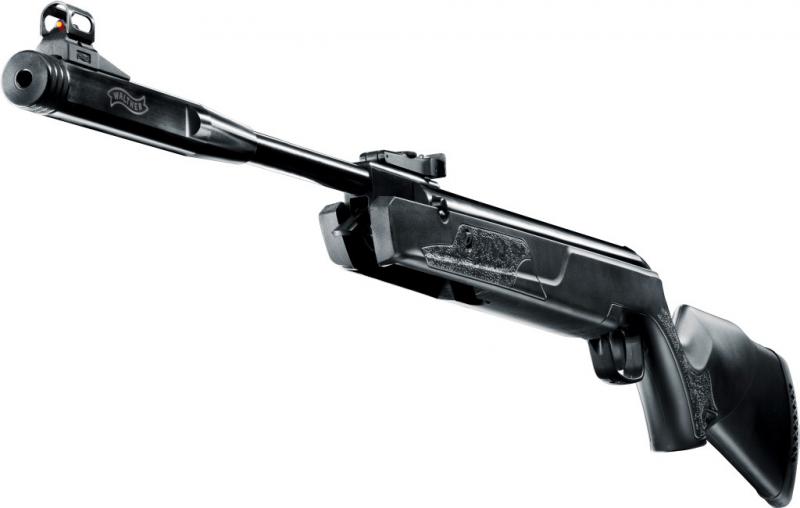
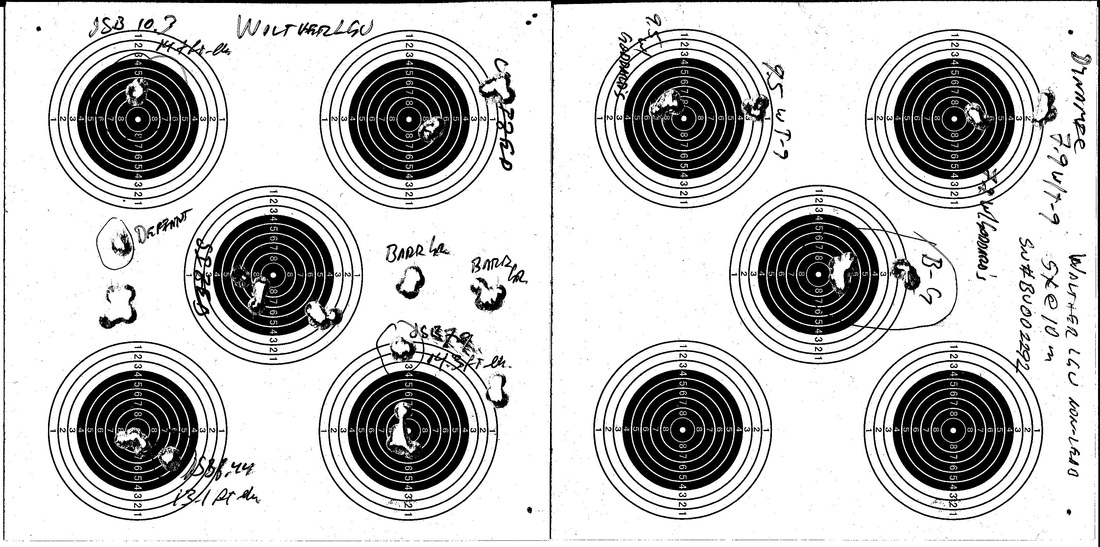
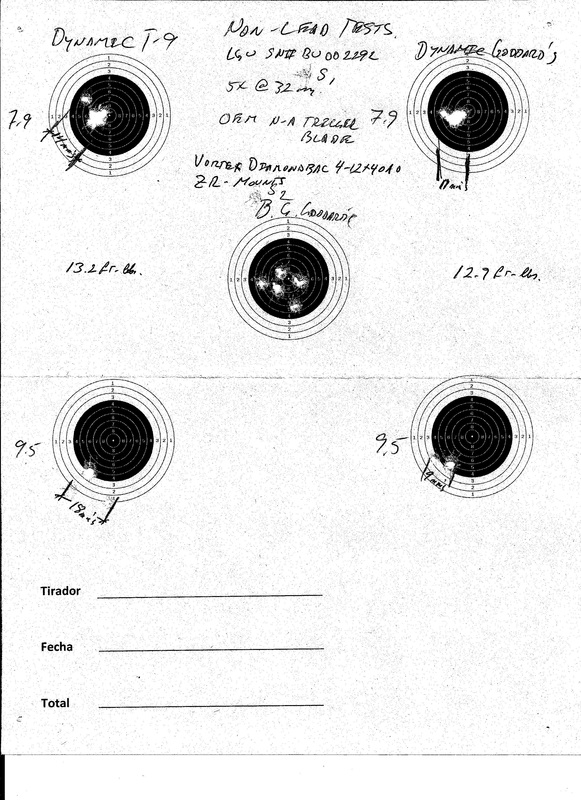
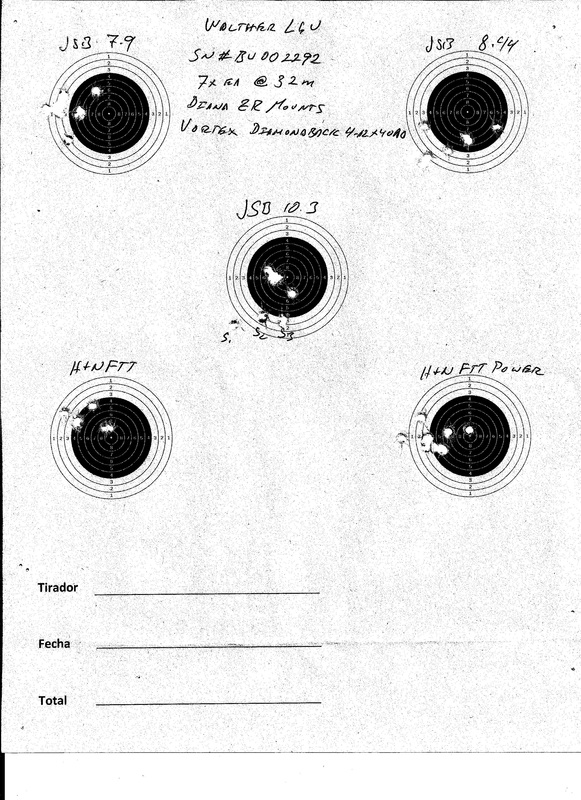
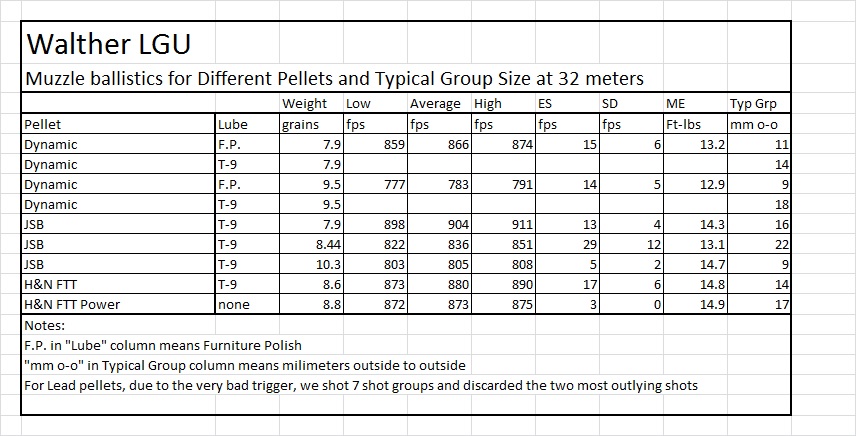
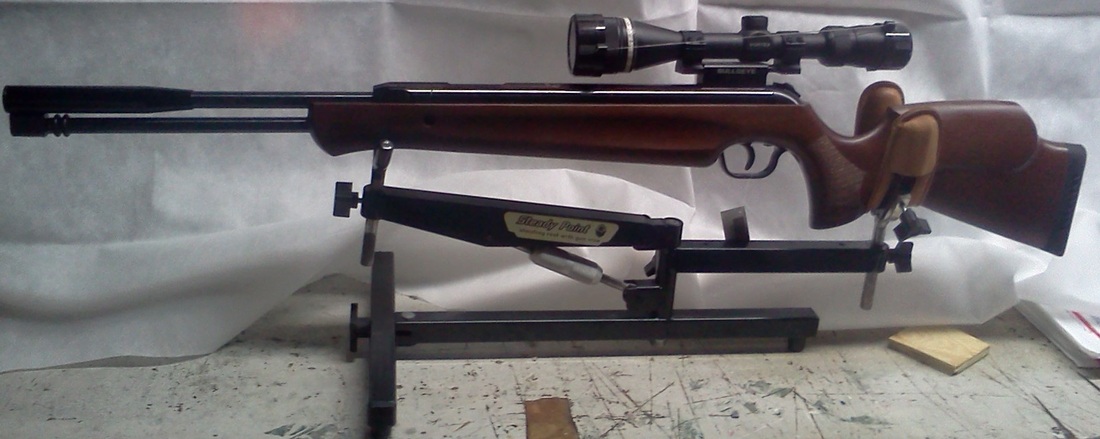
 RSS Feed
RSS Feed